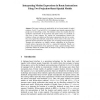Free Online Productivity Tools
i2Speak
i2Symbol
i2OCR
iTex2Img
iWeb2Print
iWeb2Shot
i2Type
iPdf2Split
iPdf2Merge
i2Bopomofo
i2Arabic
i2Style
i2Image
i2PDF
iLatex2Rtf
Sci2ools
85
Voted
KI
2008
Springer
2008
Springer
Interpreting Motion Expressions in Route Instructions Using Two Projection-Based Spatial Models
This paper explores the applicability of two formal models of spatial relations, Double Cross and RfDL3-12, to interpret some typical expressions that people use for describing a route. The relations in these two models allow the qualitative representation of the location and spatial extent of a landmark as seen from a route segment. We explore the correspondence between the relations in these two models and the motion expressions that refer to a pointlike and a region-like landmark, respectively, which consist of the same set of direction-related expressions and specific sets of topology-related expressions. Through this exploration, we identify intrinsic ambiguities in the directionrelated motion expressions that refer to a region-like landmark. Finally, we propose the generalization of our approach by using a spatial ontology, which potentially enables the mobile robots to interpret a large variety of expressions in human route instructions.
| Added | 13 Dec 2010 |
| Updated | 13 Dec 2010 |
| Type | Journal |
| Year | 2008 |
| Where | KI |
| Authors | Yohei Kurata, Hui Shi |
Comments (0)

